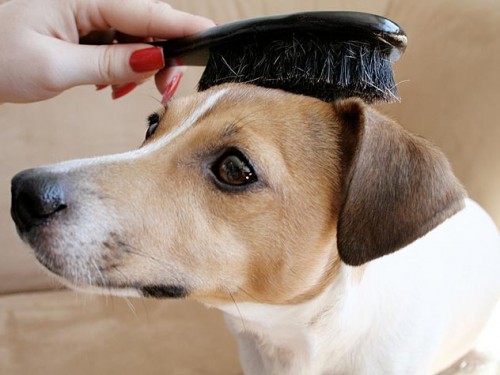How To Bathe a Dog: More Tips
Even though a good bath is one of the kindest things you can give your shelter’s dogs, chances are they’re not going to see it that way. But while you probably won’t win the hearts of all canines by getting them wet, you can make the experience more pleasant for both you and the dogs if you follow these steps. These instructions are appropriate for friendly shelter dogs in need of just a bit of cleaning. Heavily matted or aggressive dogs should be handled by a professional groomer.
1. Put on Your Wet Suit

2. Prepare the Pooch
Before starting the bath, you may want to let the dog get accustomed to you, and give her a chance to relieve herself. If the animal is particularly nervous, consider muzzling her and asking a partner to help you. Try to comb out major snarls in the dog’s fur, and trim her nails to keep her from clawing you accidentally. Put a drop of mineral oil in each of the dog’s eyes and cotton balls in her ears to keep water and soap from getting in them. Be sure to remove the cotton balls after the bath!
3. Lather, Rinse, Repeat
If the dog is heavy, don a back brace. Then lift the dog into the tub. Use a lightweight spray hose that can be maneuvered with one hand. Test the water temperature before spraying the dog, then gently get the dog used to the temperature by spraying water on her back and shoulders. After the dog relaxes, begin washing her head and then move gradually toward her rear; this will prevent fleas from moving up her body and congregating on her head and face. Lather the animal with a mild shampoo formulated for dogs. The active ingredient should be chlorhexidine, which is mildly antiseptic. If you must use an insecticide, use a gentle pyrethrin-based shampoo, and be sure to follow the safety instructions on the bottle. Oatmeal shampoos are good for dogs with itchy skin.
4. Make Fluffy Fluffy
Scrub and rinse the dog thoroughly. Soap stays in the fur long after it seems to be gone, so keep rinsing. When you finish, rub the dog down thoroughly with towels. Don’t put a wet dog back in her cageit’s okay if she’s just damp, especially if you have a climate-controlled facility. If you use an automated dryer that hangs on the front of the cage, test the temperature of the air before aiming it toward the dog, and check on the animal at least every 15 minutes or so to make sure she’s comfortable.
5. Suds Up the Puppies
Puppies have special bathing needs. Don’t use an insecticidal shampoo on a puppy unless the shampoo is formulated specifically for puppies and the puppy actually has fleas. With a young dog, it’s especially important to use warm water and make his bathing experience pleasant, using just the right combination of gentleness and firmness. If you are kind and sensitive to their fears, puppies will begin to regard their baths with pleasure rather than dread, making life more pleasant for you, for the puppies, and eventually for their adoptive families.
« Pup-tato Skins Recipe Next Post
Veterinary Eye Doctors Rally to Aid Assistance Dogs »





